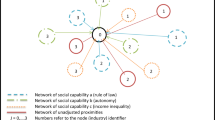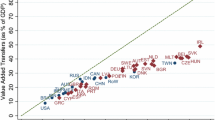Abstract
During the last two decades, two important contributions have reshaped our understanding of international trade. First, countries trade more with those with whom they share history, language, and culture, suggesting that trade is limited by information frictions. Second, countries are more likely to start exporting products that are related to their current exports, suggesting that shared capabilities and knowledge diffusion constrain export diversification. Here, we join both of these streams of literature by developing three measures of bilateral relatedness and using them to ask whether the destinations to which a country will increase its exports of a product are predicted by these forms of relatedness. The first form is product relatedness, and asks whether a country already exports many similar products to a destination. The second is importer relatedness, and asks whether the country exports the same product to the neighbors of the target destination. The third is exporter relatedness, and asks whether a country’s neighbors are already exporting the same product to the destination. We use bilateral trade data from 2000 to 2015, and a variety of controls in multiple gravity specifications, to show that countries are more likely to increase their exports of a product to a destination when they have more product relatedness, importer relatedness, and exporter relatedness. Then, we use several sample splits to explore whether the effects of these forms of relatedness are stronger for products of higher complexity, technological sophistication, and differentiation. We find that, in the case of product relatedness, the effects are stronger for differentiated, complex, and technologically sophisticated products. Also, we find the effects of common language and shared colonial past to increase with differentiation, complexity, and technological sophistication, while the effects of shared borders decrease with these three variables. These results suggest that product relatedness and common language capture dimensions of knowledge relatedness that are more important for the exchange of more sophisticated and differentiated products. These findings extend the ideas of relatedness to bilateral trade and show that the evolution of bilateral trade networks are shaped by relatedness among products, exporters, and importers.



Similar content being viewed by others
Notes
Note: We dropped singleton observations, when we apply three-way error clustering (Correia 2015).
Available at http://www.freit.org/TradeResources/TradeData.php
References
Anderson JE (1979) A theoretical foundation for the gravity equation. Am Econ Rev 69(1):106–116
Anderson JE, Marcouiller D (2002) Insecurity and the pattern of trade: an empirical investigation. Rev Econ Stat 84(2):342–352
Bahar D, Hausmann R, Hidalgo CA (2014) Neighbors and the evolution of the comparative advantage of nations: Evidence of international knowledge diffusion? J Int Econ 92(1):111–123
Bailey M, Cao RR, Kuchler T, Stroebel J, Wong A (2017) Measuring social connectedness. NBERWorking Paper No. 23608
Balassa B (1965) Trade liberalisation and “revealed” comparative advantage. Manchester School 33(2):99–123
Boschma R, Balland P-A, Kogler DF (2014) Relatedness and technological change in cities: The rise and fall of technological knowledge in US metropolitan areas from 1981 to 2010. Ind Corp Chang 24(1):223–250
Boschma R, Minondo A, Navarro M (2013) The emergence of new industries at the regional level in Spain: a proximity approach based on product relatedness. Econ Geogr 89(1):29–51
Breschi S, Lissoni F (2009) Mobility of skilled workers and co-invention networks: an anatomy of localized knowledge flows. J Econ Geogr 9(4):439–468
Casella A, Rauch JE (2002) Anonymous market and group ties in international trade. J Int Econ 58(1):19–47
Chaney T (2014) The network structure of international trade. Am Econ Rev 104(11):3600–3634
Combes P-P, Lafourcade M, Mayer T (2005) The trade-creating effects of business and social networks: Evidence from France. J Int Econ 66(1):1–29
Correia S (2015) Singletons, cluster-robust standard errors and fixed effects: a bad mix. Technical Note, Duke University
Feenstra RC, Lipsey RE, Deng H, Ma AC, Mo H (2005) World trade flows: 1962-2000. NBER Working Paper No. 11040
Gao J, Jun B, Pentland A, Zhou T, Hidalgo CA (2017) Collective learning in China’s regional economic development. arXiv:1703.01369
Garmendia A, Llano C, Minondo A, Requena F (2012) Networks and the disappearance of the intranational home bias. Econ Lett 116(2):178–182
Guevara MR, Hartmann D, Aristarán M, Mendoza M, Hidalgo CA (2016) The research space: Using career paths to predict the evolution of the research output of individuals, institutions, and nations. Scientometrics 109(3):1695–1709
Hausmann R, Hidalgo CA, Bustos S, Coscia M, Simoes A, Yildirim MA (2014) The atlas of economic complexity: Mapping paths to prosperity. MIT Press, Cambridge
Heckscher EF, Ohlin BG (1991) Heckscher-Ohlin trade theory. MIT Press, Cambridge
Helpman E (1987) Imperfect competition and international trade: Evidence from fourteen industrial countries. Journal of the Japanese and International Economies 1 (1):62–81
Hidalgo CA (2015) Why information grows: the evolution of order, from atoms to economies. Basic Books, New York
Hidalgo CA, Balland P-A, Boschma R, Delgado M, Feldman M, Frenken K, Glaeser E, He C, Kogler DF, Morrison A, et al. (2018) The principle of relatedness. In: International conference on complex systems. Springer, pp 451–457
Hidalgo CA, Hausmann R (2009) The building blocks of economic complexity. Proc Natl Acad Sci USA 106(26):10570–10575
Hidalgo CA, Klinger B, Barabási A-L, Hausmann R (2007) The product space conditions the development of nations. Science 317(5837):482–487
Kogler DF, Rigby DL, Tucker I (2013) Mapping knowledge space and technological relatedness in US cities. Eur Plan Stud 21(9):1374–1391
Krugman P (1979) Increasing returns, monopolistic competition, and international trade. J Int Econ 9(4):469–479
Krugman P (1991) Increasing returns and economic geography. J Polit Econ 99(3):483–499
Lall S (2000) The technological structure and performance of developing country manufactured exports, 1985-98. Oxf Dev Stud 28(3):337-369
Mayer T, Zignago S (2011) Notes on CEPII’s distances measures: the geodist database. CEPII Working Paper No. 2011-25
McCallum J (1995) National borders matter: Canada-US regional trade patterns. Am Econ Rev 85(3):615–623
Morales E, Sheu G, Zahler A (2015) Extended gravity. NBER Working Paper 21351
Neffke F, Henning M, Boschma R (2011) How do regions diversify over time? Industry relatedness and the development of new growth paths in regions. Econ Geogr 87(3):237–265
Parsons C, Vézina PL (2018) Migrant networks and trade: the Vietnamese boat people as a natural experiment[J]. Econ J 128(612):F210–F234
Petropoulou D (2008) Information costs, networks and intermediation in international trade. CEP Discussion Paper No. 848
Portes R, Rey H (2005) The determinants of cross-border equity flows. J Int Econ 65(2):269–296
Pöyhönen P (1963) A tentative model for the volume of trade between countries. Weltwirtschaftliches Archiv, 93–100
Rauch JE (1999) Networks versus markets in international trade. J Int Econ 48(1):7–35
Rauch JE (2001) Business and social networks in international trade. J Econ Lit 39(4):1177–1203
Rauch JE, Trindade V (2002) Ethnic Chinese networks in international trade. Rev Econ Stat 84(1):116– 130
Ronen S, Gonçalves B, Hu KZ, Vespignani A, Pinker S, Hidalgo CA (2014) Links that speak: the global language network and its association with global fame. Proc Natl Acad Sci USA 111(52):E5616–E5622
Simoes AJG, Hidalgo CA (2011) The economic complexity observatory: An analytical tool for understanding the dynamics of economic development. In: Proceedings of the 17th AAAI conference on scalable integration of analytics and visualization. AAAIWS’11-17. AAAI Press, pp 39–42
Singh J (2005) Collaborative networks as determinants of knowledge diffusion patterns. Manag Sci 51(5):756–770
Tinbergen J (1962) Shaping the world economy. Twentieth Century Fund, New York
Acknowledgments
We thank Mauricio (Pacha) Vargas and Alex Simoes for help with the data. We also thank Cristian-Jara Figueroa, Flávio Pinheiro, Tarik Roukny, Dogyoon Song, and Robert A Irwin for helpful comments. This project is supported by the MIT Skoltech Program, by the National Research Foundation of Korea (NRF) (No. 2019R1G1A1100322), and by the Cooperative Agreement between the Masdar Institute of Science and Technology (Masdar Institute), Abu Dhabi, UAE and the Massachusetts Institute of Technology (MIT), Cambridge, MA, USA—Reference 02/MI/MIT/CP/11/07633/GEN/G/00. CAH also acknowledges the support of the ANITI Chair from the University of Toulouse. This paper was circulated as a working paper: “Relatedness, knowledge diffusion, and the evolution of bilateral trade.” arXiv preprint arXiv:1709.05392 (Sep 2017).
Author information
Authors and Affiliations
Corresponding author
Additional information
Publisher’s note
Springer Nature remains neutral with regard to jurisdictional claims in published maps and institutional affiliations.
Appendices
Appendix A: Building a product space for 2000–2015
To calculate the ωopd, we need first build a product space. We define the product space by looking at all proximity measures between products (Hidalgo et al. 2007) after aggregating all the data that covers from 2000 to 2015. To capture the significant trade flow, we calculate the revealed comparative advantage (RCA) following Balassa (1965):
Based on the result of RCA, we measure the proximity between product by calculating ϕi, j between product i and j (Hidalgo et al. 2007).
Using this significant trade flow over 2000–2015, we can create 1242 × 1242 matrix, which entities the proximity between products. Figure 4 shows the product space of world market in the period from 2000 to 2015.
Appendix B: Regression results without three-way error clustering
Appendix C: Fixed effects model
Appendix D: Rauch classification
Appendix E: Summary statistics and correlation table
Appendix F: Relationship between bilateral trade volume after two years and the three learning channels by exporters’ comparative advantage
We also test the effects of the exporters’ levels of competitiveness on the diffusion of the information needed to trade by dividing exporters of each product into small, medium, and large exporters (Table 17). We do this by calculating the revealed comparative advantage (RCA) of each exporter in each product. RCA is the ratio between the exports of a country in a product, and the exports that are expected based on a country’s total export market and the size of the global market for that product. We classify as small exporters all countries with an RCA below 0.2 in a product (countries that export less than 20% of what they are expected to export by chance). We classify as medium exporters all countries with an RCA between 0.2 and 1. We classify as the large exporters of a product all countries that have revealed comparative advantage in it (RCA > 1). To rule out temporary changes of exporters’ comparative advantage, we restrict the condition for being a small, medium, and large exporter: small, medium, and large exporters need to keep RCA below 0.2, between 0.2 and 1, and above 1 for three years before the beginning of the period.
Table 17 divide country-product pairs into small, medium, and large exporters. The results are consistent with those presented in Table 2, but also reveal two important distinctions. First, the effects of product and geographic relatedness, especially exporter relatedness, are stronger for small exporters, suggesting that knowledge and information frictions impose larger constraints for countries that are not exporting a product on a large scale. Second, the overall explanatory power of the model is considerably larger for large exporters (R2 ≈ 53% vs R2 ≈ 46% for medium exporters and R2 ≈ 28% for small exporters; these are large differences, even considering that the sample sizes are not the same). This suggests that smaller exporters face more uncertainty (less predictable because of lower R-squared), and, hence, other factors are needed to predict their bilateral trade volume.
Rights and permissions
About this article
Cite this article
Jun, B., Alshamsi, A., Gao, J. et al. Bilateral relatedness: knowledge diffusion and the evolution of bilateral trade. J Evol Econ 30, 247–277 (2020). https://doi.org/10.1007/s00191-019-00638-7
Published:
Issue Date:
DOI: https://doi.org/10.1007/s00191-019-00638-7





